After just returning from the CLM Annual Conference, where the industry's best and brightest gather, two things that some argue should never be mentioned in the same sentence were once again spoken; "Moneyball", and Lawyers. The idea of “Moneyball” for lawyers is again fresh and topical, and industry leaders are applying a brand of “saber metrics” to counsel. As many know, Moneyball was a highly successful book by Michael Lewis analyzing the use of metrics in baseball. We have talked about this for years, its application to use on Litigation Management and counsel, and what it means to our clients and the industry. The reality is not whether or not to use metrics (that is already well settled; the answer is yes) but rather, what do with them. The real question for our clients is “what is a win?” for them and “what value does counsel bring over replacement counsel?” Here is how I believe our clients and industry leaders will use metrics to differentiate in the future:
1. Outcome— Defining and achieving your goals
2. Risk— Harm avoided
3. Process— How was this achieved and how long did it take.
4. Predictability— How certain are we of cost to achieve outcome
Outcome.
Many attorneys in the litigation arena define the goal as winning at trial or paying nothing to the other-side. However, these goals are generally illusory. First on the civil litigation side 97% of cases are resolved without a trial. Thus, there is little to any benefit measuring success on what is essentially of 3% of your cases. Second paying nothing to the other side means nothing to a client, if you regularly pay your attorney more than it would cost to resolve the case outright. This is especially true if you are doing this over a large volume of say 6,000 cases a year. We suggest that “total case outcome” is measured in dollars, and in sense both in terms of actual indemnity and attorneys fees, as well as counsel's subjective value (sense) and then measuring the deviation from that predicted plan number at the outset of litigation, and again at the conclusion. This number should be within 10% absent some significant new developments in litigation which substantial change.
Risk.
The second component of value is risk or harm avoided. The key concept from the book "Moneyball" is about VORP, or value over replacement player. Many attorneys assert that there is an inherent risk in not using their firm and that their attorneys bring you value. However, they never define that value properly, or rather base their value solely on trial experience. We show our clients the value of our services which makes the risk of using us versus a 100 other attorneys easy to show. Specifically, we quantify in tailored metrics the cycle time, total case outcome, and total fees as just a few key indicators of value and provide this information back to our clients regularly. We actually then compare this side by side with their existing counsel or industry averages from our proprietary database to show in black and white our value in dollars and "sense" versus our competitors.
Process.
This is often overlooked and is a key component of measuring value. In every situation, timeliness, complexity and cost are important considerations. As most legal commentators have stated, “most legal matters are repetitive in some way.” Thus, handling each case according to a defined process and improving on each new matter is paramount to success. This is one of the reasons why cycle time is so important to our clients. Essentially, it is one indicator of how important efficiency is in the process and how we are doing on it.
Predictability.
With most of our insurance clients, their business is run by predictions. Underwriters and actuaries make a living by determining what they can charge, and what they will profit based on risk. The same holds true with litigation. If we can state with certainty the cost of defending a matter to our clients, and agree to the value of legal fees, we have removed uncertainty.Finally, although the industry has recognized that talking metrics is good, clients and counsel need to move talk to implementation and true measurement. The next steps will be implementing VORF (Value Over Replacement Firm) and using this to measure the "batting averages" of firms to determine the industries best players. After all, with baseball or with legal, we only want to reward the best players for the best results. Daniel P. Costello & Associates, LLC specializes in construction litigation, complex litigation, and litigation management.







